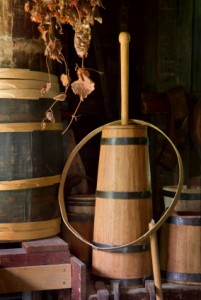 Butter is one of those delightful foods that has one ingredient: in this case, cream—optionally cultured, chilled to below room temperature, and churned (agitated until the butter agglomerates and the buttermilk separates). The classic Western butter comes from the cream of cow’s milk; the milk of sheep and goats require different methods to produce anything recognizable as butter, and its similarity is debatable. American butter is usually salted, European butter typically not. Salting does not alter any aspect of the finished product but perhaps its taste.
Butter is one of those delightful foods that has one ingredient: in this case, cream—optionally cultured, chilled to below room temperature, and churned (agitated until the butter agglomerates and the buttermilk separates). The classic Western butter comes from the cream of cow’s milk; the milk of sheep and goats require different methods to produce anything recognizable as butter, and its similarity is debatable. American butter is usually salted, European butter typically not. Salting does not alter any aspect of the finished product but perhaps its taste.
Making butter at home makes the most sense economically if you, or perhaps a neighbor, keep a cow or cows, and thus you have access to a ready supply of cream. Buying cream to make butter would be an expensive hobby, as well as a potentially labor-intensive one. The exception, if you find you enjoy making small occasional batches of butter, would be keeping your eye out for markdowns on whipping cream or double cream—since they have a shorter regulated shelf life than that of butter, they are more likely to be marked down in the event of an overstock or slow sales.
What Happens in Churning?
Churning basically turns cream, or butterfat, inside out. What starts as separately imperceptible droplets of fat suspended in liquid ends up with a separate liquid (buttermilk) and the fat (butter) now incorporating some 14 to 20 per cent droplets of water. In industrially produced butter, these water droplets are homogenized into invisibility. You can do something like this at home too. However, you can actually leave your butter more marbled, with visible pockets of fattier and moister butter. This result is more rollable than a more homogeneous butter, and makes great croissants and other pastries.
Shaking the cream (in the oldest methods), agitating it with a plunger, or whipping it with paddles breaks down fat droplets separately suspended in liquid. These are the traditional tools and techniques. These days, for small batches you can also use an electric mixer, food processor or blender. If you have more than one of these appliances, you can see which works best for you. The quick version goes like this:
Whip cream at a bit below room temperature into peaks. With continued whipping, its fat clumps into butter grains; as these agglomerate, the foam forms a more viscous mass.
Eventually the butter “breaks”; fatty bubbles pop and collapse, yellow solids appear, and any liquid not incorporated into the fat mass separates as buttermilk.
Very quickly after breaking, the fat forms into large lumps, and any electric appliance pressed into service as a butter churn needs to be switched off immediately before it jams or begins flinging fatty and milky bits all over the kitchen. Once fat and liquid separate, the buttermilk is drained off, and the fat—now recognizable as butter—gets rinsed in ice water, has excess water kneaded out of it and gets formed.
So Now I Have…
Buttermilk makes lovely pancakes, biscuits, and quick breads, and can be used in soups, sauces, and salad dressings. Most cats like it too. (As many cat-owners can attest, more cats like milk than can tolerate it, so be aware!)
The most meticulous home butter-makers have no qualms about freezing butter for up to several months; it actually crystallizes near room temperature, so no textural changes occur between refrigeration and freezing. Also, as you cruise butter-making sites, note the hint offered on several of them to put one’s butter up in rolls rather than trying to make commercially-shaped sticks.
God Is in the Details
Jonathan S. White offers a helpfully detailed description of what the various churning stages look like when using a food processor. He’s also very thorough in specifying the best cream to use, and temperatures and techniques that can help maximize your success. White favors using clabber cream, yogurt, buttermilk or sour cream to culture the cream before churning. Finally, he stresses hygiene and offers reasonable suggestions for the vexed question of pasteurization.
Personally, I would start out with trying small batches using my blender—which happens to helpfully have a base bigger than its mouth—or my food processor. I think if I needed larger batches for a family, or if the time, materials, and labor calculations worked out well enough to consider selling or bartering my butter, I would look into investing in a larger, dedicated churn. Both mechanical and electric models are readily available.
One thing that intrigues me most about churning is the potential home social aspect of it. I wonder how much it is like hand-cranking ice cream, and how many conversations I might have with family members while one of us churns a batch of butter and the other shells some peas, much like the less hectic times of our parents’ generation.
Other articles in this issue:
- Equal Taxation for All
- Why Worry About High Blood Pressure?
- Why Monetizing Debt Leads To Higher Precious Metals Prices
If you liked this article you may be interested in this product from our sponsor.

 Off The Grid News Better Ideas For Off The Grid Living
Off The Grid News Better Ideas For Off The Grid Living



